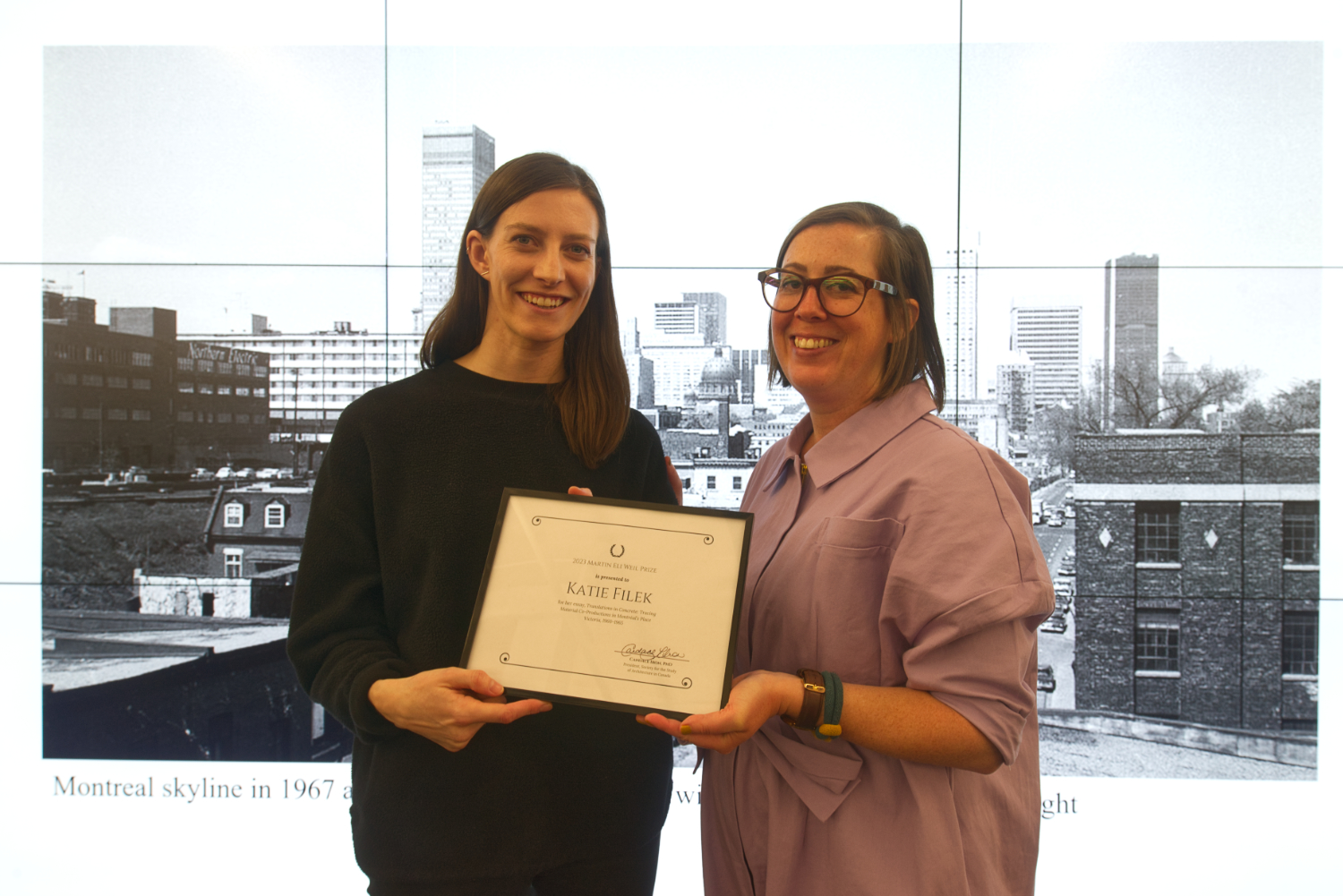
16.08.23 - ALD PhD student Katie Filek receives SSHRC fellowship, SSAC’s Martin Eli Weil Prize
The Daniels Faculty’s Katie Filek, who is pursuing a PhD degree in Architecture, Landscape, and Design, has pulled off an impressive double awards feat over the past few months, garnering both a doctoral fellowship from the Government of Canada’s Social Sciences and Humanities Research Council (SSHRC) and the Martin Eli Weil Prize from the Society for the Study of Architecture in Canada (SSAC).
Part of the 2021 ALD PhD cohort, Filek has been researching the transnational circulation of architectural knowledge in the 20th century, focusing specifically on transnationalism in postwar Canadian architecture and on how foreign expertise was introduced, circulated and translated through media and through local professional and material conditions.
Postwar links between Canada and Italy—especially buildings designed by prominent Italian architects in and for Canada in the 1950s and 1960s—are of particular interest to Filek.
Fluent in several languages, she earned her master’s degree in architecture from the Politecnico di Milano in Italy and expects to complete her PhD degree at Daniels in 2026. Her doctoral advisor is Associate Professor Mary Lou Lobsinger.
Awarded to “high-calibre students engaged in doctoral programs in the social sciences and humanities,” SSHRC fellowships are intended to allow scholars “to fully focus on their doctoral studies, to seek out the best research mentors in their chosen fields, and to contribute to the Canadian research ecosystem during and beyond the tenure of their awards.”
The Martin Eli Weil Prize, meanwhile, is awarded annually by the SSAC to the best essay submitted by a student on the role of the built environment in Canadian society. The prize is handed out at the Society’s annual assembly, where the recipient is also is invited to deliver the winning paper to conference attendees.
Filek presented her essay, titled “Translations in Concrete: Tracing Material Co-productions in Montreal’s Place Victoria, 1960-1965,” at the SSAC’s 2023 gathering, held from May 31 to June 3 at the University of Calgary.
“The paper was written following work in two seminar courses at Daniels, with Mary Lou Lobsinger and then Jason Nguyen, and focuses on the design and construction of Montreal’s Stock Exchange Tower—also known as Place Victoria—and the collaboration that took place between Italian and Canadian professionals over the course of the project,” says Filek.
As a skyscraper made of reinforced concrete, Place Victoria—the inauguration of which is pictured below—was anomalous at the time in North America and drew on Italian expertise in concrete construction, yet also relied on the expertise of local architects and engineers in Montreal to translate the design to suit local conditions of economy, climate and labour, Filek adds.
Concrete, she explains, “offers a way to read these modifications, and to trace networks of materials and expertise across the Atlantic. Within my larger doctoral research project, this paper has helped frame my investigation of Place Victoria and offers a case study of a material as a medium of exchange.”

Above: The 1964 inauguration of Montreal’s Stock Exchange Tower, a.k.a. Place Victoria, was captured by photographer Henri Rémillard. The photo is from the Bibliothèque et archives nationales du Québec (BanQ)
Looking forward, Filek says, “my SSHRC grant will be extremely helpful as I move from coursework into my dissertation research. As this research will involve visiting archives across Canada and in Europe, the grant will help offset the costs of these archival visits and help move my research forward.”
Among the overseas archives on Filek’s travel list is a Roman one holding “archival material of the Italian developer who was behind Place Victoria and other projects in Montreal.” Through such investigations abroad, she aims to shed light on not only on Canada’s architectural past, but also on the ways its present and future may unfold.
“In the case of Canada, its architecture has developed largely through exchange and the international mobility of people, ideas and technologies—yet much of the scholarship on Canada’s architecture focuses on cases within the country’s borders,” she says.
“With my own research I’m aiming to investigate Canada’s built environment in relation to broader international networks and flows, and to open up ways of looking expansively at the processes and mechanisms driving its development. I see this approach as both making an important contribution to the historiography of Canadian architecture and bringing it into dialogue with themes in the broader field of architectural history. At the same time, I hope that highlighting these global flows of people, materials and capital in architecture might also help inform current approaches to the built environment, thinking beyond borders.”
Filek’s transnational focus extends to other work as well. Alongside her doctoral studies, she is the co-editor with Paris-based researcher Marc-Antoine Durand of a publishing project called As Found Editions, which examines architectural texts and their translations, primarily through archival material, as tools of exchange.
The pair is also working on a book project with Paris’s Pavillon de l’Arsenal titled Translating: Architecture, for which they are gathering texts from an international group of emerging architects, written in their own language and then translated into English and French, with aim of exploring the diversity of contemporary definitions of architecture.
Banner image: ALD PhD student Katie Filek (left) shows off her Martin Eli Weil Prize certificate alongside colleague and mentor Jessica Mace, a Postdoctoral Fellow in Canadian Architecture and Landscapes in the Department of Art History at U of T. Filek was awarded the MEW Prize by the Society for the Study of Architecture in Canada for her essay entitled “Translations in Concrete: Tracing Material Co-productions in Montreal’s Place Victoria, 1960-1965,” which she presented at the SSAC’s 2023 gathering in Calgary.

